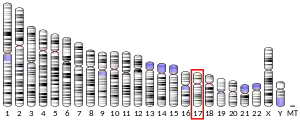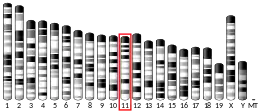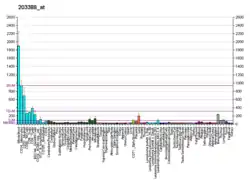Arrestin beta 2
Beta-arrestin-2, also known as arrestin beta-2, is an intracellular protein that in humans is encoded by the ARRB2 gene.
Members of arrestin/beta-arrestin protein family are thought to participate in agonist-mediated desensitization of G protein-coupled receptors and cause specific dampening of cellular responses to stimuli such as hormones, neurotransmitters, or sensory signals,[5][6][7] as well as having signalling roles in their own right.[8][9][10][11][12] Arrestin beta 2, like arrestin beta 1, was shown to inhibit beta-adrenergic receptor function in vitro. It is expressed at high levels in the central nervous system and may play a role in the regulation of synaptic receptors. Besides the brain, a cDNA for arrestin beta 2 was isolated from thyroid gland, and thus it may also be involved in hormone-specific desensitization of TSH receptors. Multiple alternatively spliced transcript variants have been found for this gene, but the full-length nature of some variants has not been defined.[13]
The protein may interact with the agonist DOI in 5-HT2A receptor signaling.[14][15]
Arrestin beta 2 is crucial for the development of tolerance to morphine and other opioids.
Interactions
Arrestin beta 2 has been shown to interact with
References
- GRCh38: Ensembl release 89: ENSG00000141480 - Ensembl, May 2017
- GRCm38: Ensembl release 89: ENSMUSG00000060216 - Ensembl, May 2017
- "Human PubMed Reference:". National Center for Biotechnology Information, U.S. National Library of Medicine.
- "Mouse PubMed Reference:". National Center for Biotechnology Information, U.S. National Library of Medicine.
- Breivogel CS, Lambert JM, Gerfin S, Huffman JW, Razdan RK (July 2008). "Sensitivity to delta9-tetrahydrocannabinol is selectively enhanced in beta-arrestin2 -/- mice". Behavioural Pharmacology. 19 (4): 298–307. doi:10.1097/FBP.0b013e328308f1e6. PMC 2751575. PMID 18622177.
- Li Y, Liu X, Liu C, Kang J, Yang J, Pei G, Wu C (March 2009). "Improvement of morphine-mediated analgesia by inhibition of β-arrestin2 expression in mice periaqueductal gray matter". International Journal of Molecular Sciences. 10 (3): 954–63. doi:10.3390/ijms10030954. PMC 2672012. PMID 19399231.
- Zheng H, Loh HH, Law PY (January 2008). "Beta-arrestin-dependent mu-opioid receptor-activated extracellular signal-regulated kinases (ERKs) Translocate to Nucleus in Contrast to G protein-dependent ERK activation". Molecular Pharmacology. 73 (1): 178–90. doi:10.1124/mol.107.039842. PMC 2253657. PMID 17947509.
- Ma L, Pei G (January 2007). "Beta-arrestin signaling and regulation of transcription". Journal of Cell Science. 120 (Pt 2): 213–8. doi:10.1242/jcs.03338. PMID 17215450.
- Defea K (March 2008). "Beta-arrestins and heterotrimeric G-proteins: collaborators and competitors in signal transduction". British Journal of Pharmacology. 153 Suppl 1 (S1): S298-309. doi:10.1038/sj.bjp.0707508. PMC 2268080. PMID 18037927.
- Barki-Harrington L, Rockman HA (February 2008). "Beta-arrestins: multifunctional cellular mediators". Physiology. 23: 17–22. doi:10.1152/physiol.00042.2007. PMID 18268361.
- Patel PA, Tilley DG, Rockman HA (March 2009). "Physiologic and cardiac roles of beta-arrestins". Journal of Molecular and Cellular Cardiology. 46 (3): 300–8. doi:10.1016/j.yjmcc.2008.11.015. PMID 19103204.
- Golan M, Schreiber G, Avissar S (2009). "Antidepressants, beta-arrestins and GRKs: from regulation of signal desensitization to intracellular multifunctional adaptor functions". Current Pharmaceutical Design. 15 (14): 1699–708. doi:10.2174/138161209788168038. PMID 19442183.
- "ARRB2 arrestin beta 2 [ Homo sapiens (human) ]". National Center for Biotechnology Information.
- Schmid CL, Raehal KM, Bohn LM (January 2008). "Agonist-directed signaling of the serotonin 2A receptor depends on beta-arrestin-2 interactions in vivo". Proceedings of the National Academy of Sciences of the United States of America. 105 (3): 1079–84. doi:10.1073/pnas.0708862105. PMC 2242710. PMID 18195357.
- Abbas A, Roth BL (January 2008). "Arresting serotonin". Proceedings of the National Academy of Sciences of the United States of America. 105 (3): 831–2. Bibcode:2008PNAS..105..831A. doi:10.1073/pnas.0711335105. PMC 2242676. PMID 18195368.
- Laporte SA, Oakley RH, Zhang J, Holt JA, Ferguson SS, Caron MG, Barak LS (March 1999). "The beta2-adrenergic receptor/betaarrestin complex recruits the clathrin adaptor AP-2 during endocytosis". Proceedings of the National Academy of Sciences of the United States of America. 96 (7): 3712–7. Bibcode:1999PNAS...96.3712L. doi:10.1073/pnas.96.7.3712. PMC 22359. PMID 10097102.
- Kim YM, Benovic JL (August 2002). "Differential roles of arrestin-2 interaction with clathrin and adaptor protein 2 in G protein-coupled receptor trafficking". The Journal of Biological Chemistry. 277 (34): 30760–8. doi:10.1074/jbc.M204528200. PMID 12070169.
- Claing A, Chen W, Miller WE, Vitale N, Moss J, Premont RT, Lefkowitz RJ (November 2001). "beta-Arrestin-mediated ADP-ribosylation factor 6 activation and beta 2-adrenergic receptor endocytosis". The Journal of Biological Chemistry. 276 (45): 42509–13. doi:10.1074/jbc.M108399200. PMID 11533043.
- Wang P, Gao H, Ni Y, Wang B, Wu Y, Ji L, Qin L, Ma L, Pei G (February 2003). "Beta-arrestin 2 functions as a G-protein-coupled receptor-activated regulator of oncoprotein Mdm2". The Journal of Biological Chemistry. 278 (8): 6363–70. doi:10.1074/jbc.M210350200. PMID 12488444.
- Wang P, Wu Y, Ge X, Ma L, Pei G (March 2003). "Subcellular localization of beta-arrestins is determined by their intact N domain and the nuclear export signal at the C terminus". The Journal of Biological Chemistry. 278 (13): 11648–53. doi:10.1074/jbc.M208109200. PMID 12538596.
- Shenoy SK, Xiao K, Venkataramanan V, Snyder PM, Freedman NJ, Weissman AM (August 2008). "Nedd4 mediates agonist-dependent ubiquitination, lysosomal targeting, and degradation of the beta2-adrenergic receptor". The Journal of Biological Chemistry. 283 (32): 22166–76. doi:10.1074/jbc.M709668200. PMC 2494938. PMID 18544533.
- Bhattacharya M, Anborgh PH, Babwah AV, Dale LB, Dobransky T, Benovic JL, Feldman RD, Verdi JM, Rylett RJ, Ferguson SS (August 2002). "Beta-arrestins regulate a Ral-GDS Ral effector pathway that mediates cytoskeletal reorganization". Nature Cell Biology. 4 (8): 547–55. doi:10.1038/ncb821. PMID 12105416. S2CID 20784208.
Further reading
- Lefkowitz RJ (July 1998). "G protein-coupled receptors. III. New roles for receptor kinases and beta-arrestins in receptor signaling and desensitization". The Journal of Biological Chemistry. 273 (30): 18677–80. doi:10.1074/jbc.273.30.18677. PMID 9668034.
- Attramadal H, Arriza JL, Aoki C, Dawson TM, Codina J, Kwatra MM, Snyder SH, Caron MG, Lefkowitz RJ (September 1992). "Beta-arrestin2, a novel member of the arrestin/beta-arrestin gene family". The Journal of Biological Chemistry. 267 (25): 17882–90. PMID 1517224.
- Rapoport B, Kaufman KD, Chazenbalk GD (April 1992). "Cloning of a member of the arrestin family from a human thyroid cDNA library". Molecular and Cellular Endocrinology. 84 (3): R39-43. doi:10.1016/0303-7207(92)90038-8. PMID 1587386. S2CID 1964362.
- Calabrese G, Sallese M, Stornaiuolo A, Stuppia L, Palka G, De Blasi A (September 1994). "Chromosome mapping of the human arrestin (SAG), beta-arrestin 2 (ARRB2), and beta-adrenergic receptor kinase 2 (ADRBK2) genes". Genomics. 23 (1): 286–8. doi:10.1006/geno.1994.1497. PMID 7695743.
- Parruti G, Peracchia F, Sallese M, Ambrosini G, Masini M, Rotilio D, De Blasi A (May 1993). "Molecular analysis of human beta-arrestin-1: cloning, tissue distribution, and regulation of expression. Identification of two isoforms generated by alternative splicing". The Journal of Biological Chemistry. 268 (13): 9753–61. PMID 8486659.
- Le Gouill C, Parent JL, Rola-Pleszczynski M, Stanková J (February 1997). "Role of the Cys90, Cys95 and Cys173 residues in the structure and function of the human platelet-activating factor receptor". FEBS Letters. 402 (2–3): 203–8. doi:10.1016/S0014-5793(96)01531-1. PMID 9037196. S2CID 21074692.
- Barak LS, Ferguson SS, Zhang J, Caron MG (October 1997). "A beta-arrestin/green fluorescent protein biosensor for detecting G protein-coupled receptor activation". The Journal of Biological Chemistry. 272 (44): 27497–500. doi:10.1074/jbc.272.44.27497. PMID 9346876.
- Laporte SA, Oakley RH, Zhang J, Holt JA, Ferguson SS, Caron MG, Barak LS (March 1999). "The beta2-adrenergic receptor/betaarrestin complex recruits the clathrin adaptor AP-2 during endocytosis". Proceedings of the National Academy of Sciences of the United States of America. 96 (7): 3712–7. Bibcode:1999PNAS...96.3712L. doi:10.1073/pnas.96.7.3712. PMC 22359. PMID 10097102.
- Cheng ZJ, Zhao J, Sun Y, Hu W, Wu YL, Cen B, Wu GX, Pei G (January 2000). "beta-arrestin differentially regulates the chemokine receptor CXCR4-mediated signaling and receptor internalization, and this implicates multiple interaction sites between beta-arrestin and CXCR4". The Journal of Biological Chemistry. 275 (4): 2479–85. doi:10.1074/jbc.275.4.2479. PMID 10644702.
- Lin F, Wang Hy, Malbon CC (June 2000). "Gravin-mediated formation of signaling complexes in beta 2-adrenergic receptor desensitization and resensitization". The Journal of Biological Chemistry. 275 (25): 19025–34. doi:10.1074/jbc.275.25.19025. PMID 10858453.
- McDonald PH, Chow CW, Miller WE, Laporte SA, Field ME, Lin FT, Davis RJ, Lefkowitz RJ (November 2000). "Beta-arrestin 2: a receptor-regulated MAPK scaffold for the activation of JNK3". Science. 290 (5496): 1574–7. Bibcode:2000Sci...290.1574M. doi:10.1126/science.290.5496.1574. PMID 11090355.
- Luttrell LM, Roudabush FL, Choy EW, Miller WE, Field ME, Pierce KL, Lefkowitz RJ (February 2001). "Activation and targeting of extracellular signal-regulated kinases by beta-arrestin scaffolds". Proceedings of the National Academy of Sciences of the United States of America. 98 (5): 2449–54. Bibcode:2001PNAS...98.2449L. doi:10.1073/pnas.041604898. PMC 30158. PMID 11226259.
- Cen B, Yu Q, Guo J, Wu Y, Ling K, Cheng Z, Ma L, Pei G (March 2001). "Direct binding of beta-arrestins to two distinct intracellular domains of the delta opioid receptor". Journal of Neurochemistry. 76 (6): 1887–94. doi:10.1046/j.1471-4159.2001.00204.x. PMID 11259507. S2CID 83485138.
- Oakley RH, Laporte SA, Holt JA, Barak LS, Caron MG (June 2001). "Molecular determinants underlying the formation of stable intracellular G protein-coupled receptor-beta-arrestin complexes after receptor endocytosis*". The Journal of Biological Chemistry. 276 (22): 19452–60. doi:10.1074/jbc.M101450200. PMID 11279203.
- Miller WE, McDonald PH, Cai SF, Field ME, Davis RJ, Lefkowitz RJ (July 2001). "Identification of a motif in the carboxyl terminus of beta -arrestin2 responsible for activation of JNK3". The Journal of Biological Chemistry. 276 (30): 27770–7. doi:10.1074/jbc.M102264200. PMID 11356842.
- Claing A, Chen W, Miller WE, Vitale N, Moss J, Premont RT, Lefkowitz RJ (November 2001). "beta-Arrestin-mediated ADP-ribosylation factor 6 activation and beta 2-adrenergic receptor endocytosis". The Journal of Biological Chemistry. 276 (45): 42509–13. doi:10.1074/jbc.M108399200. PMID 11533043.
- Hilairet S, Bélanger C, Bertrand J, Laperrière A, Foord SM, Bouvier M (November 2001). "Agonist-promoted internalization of a ternary complex between calcitonin receptor-like receptor, receptor activity-modifying protein 1 (RAMP1), and beta-arrestin". The Journal of Biological Chemistry. 276 (45): 42182–90. doi:10.1074/jbc.M107323200. PMID 11535606.
- Shenoy SK, McDonald PH, Kohout TA, Lefkowitz RJ (November 2001). "Regulation of receptor fate by ubiquitination of activated beta 2-adrenergic receptor and beta-arrestin". Science. 294 (5545): 1307–13. doi:10.1126/science.1063866. PMID 11588219. S2CID 23486946.
- Chen Z, Dupré DJ, Le Gouill C, Rola-Pleszczynski M, Stanková J (March 2002). "Agonist-induced internalization of the platelet-activating factor receptor is dependent on arrestins but independent of G-protein activation. Role of the C terminus and the (D/N)PXXY motif". The Journal of Biological Chemistry. 277 (9): 7356–62. doi:10.1074/jbc.M110058200. PMID 11729201.
External links
- Human ARRB2 genome location and ARRB2 gene details page in the UCSC Genome Browser.
This article incorporates text from the United States National Library of Medicine, which is in the public domain.




